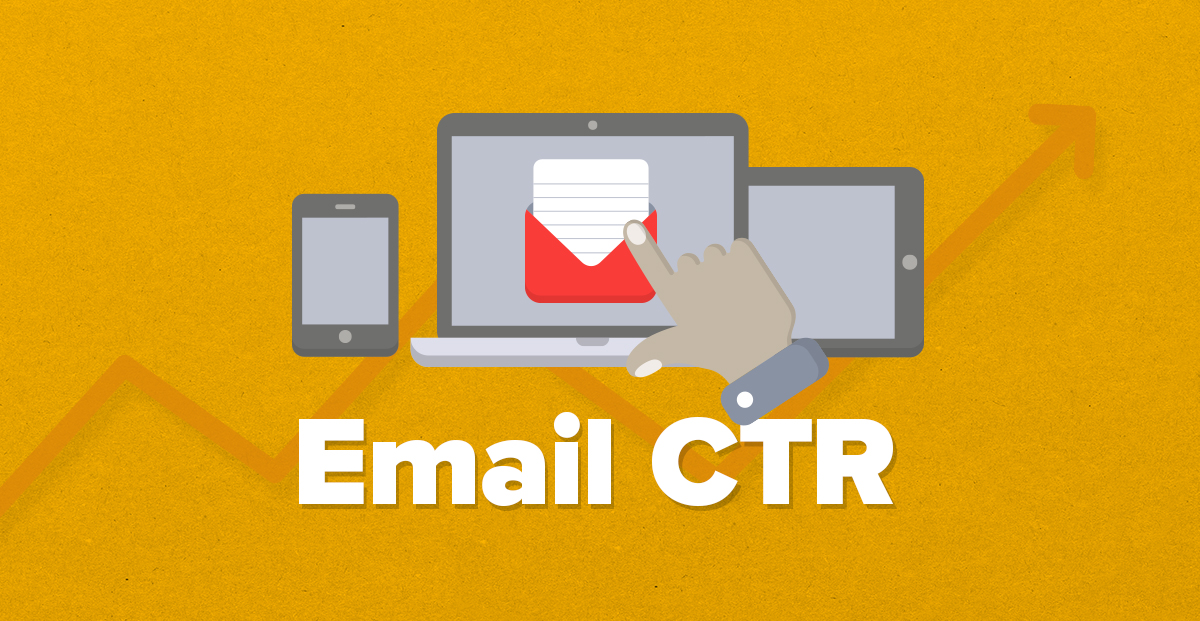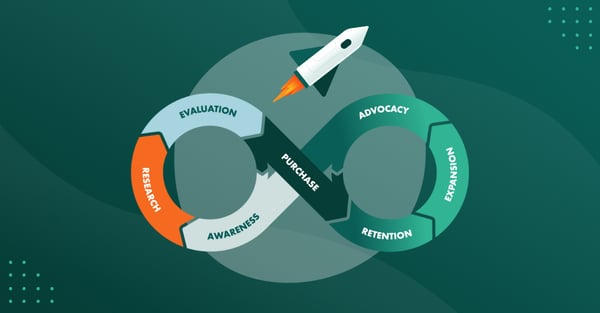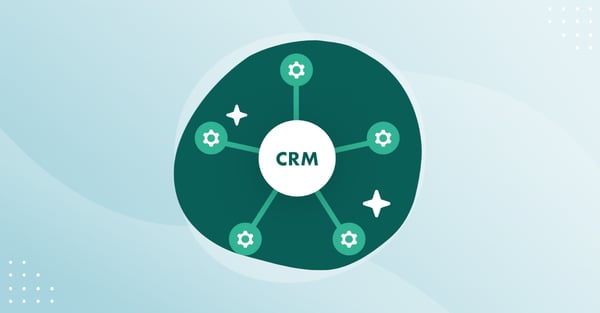Post summary:
- What is email click through rate?
- How can I increase email click-through rate?
- Case study: How one email increased CTR by 53%!
Do you know what the biggest challenge in email marketing is today?
It’s not email deliverability, or email open rates.
The challenge is getting people to take action and click on your email campaigns once they've opened and read the email content.
This is known as click through rate.
How big of a challenge is it?
According to Ascend2, 53% of email marketing professionals struggle with low click through rates.
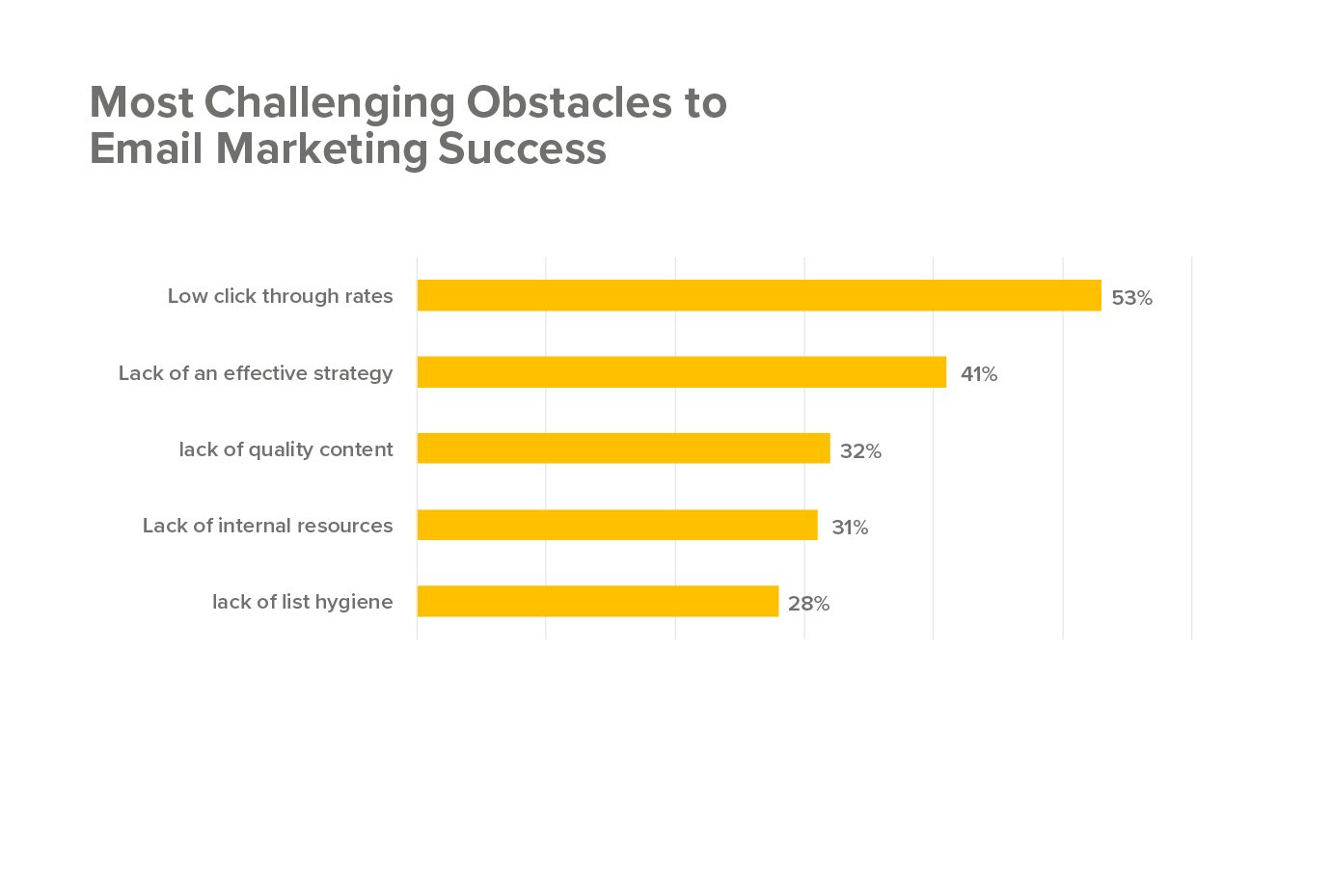
I get it.
At SuperOffice, we struggle with it too.
Our blog subscriber emails average a higher-than-average email open rate of 40%.
Yet, our email click through rate is less than 10%.
That’s right. Ten percent.
Like you, we want to increase it.
But, how do you get more people to click on your email campaigns?
Our email open rate used to be 15%.
When we wanted to find ways to increase email open rates, we deep dived into the science behind what makes people open emails and used the findings to increase open rates by 160%!
Today, we’re doing exactly the same. Only this time we’re looking at the science behind email click though rates. But, before we begin, it’s important to make sure that we’re all on the same page.
So, let’s start at the beginning.
What is email click through rate?
Email click through rate is calculated by the number of subscribers that have clicked on at least one link in your email marketing campaign.
To calculate email click through rate, take the number of people that have clicked on your email campaign and divide that with the number of emails you have sent. You can then multiply that number by 100 to show a percentage.
Here's a breakdown of the email click through rate formula:

For example, if you send an email campaign to 100 people and 10 people clicked on links within your email, then your click through rate would be 10%.
According to Ascend2 email click through rate is the most important email marketing metric as 73% of marketers’ track click through rates as a way to measure the success of their email marketing campaigns.
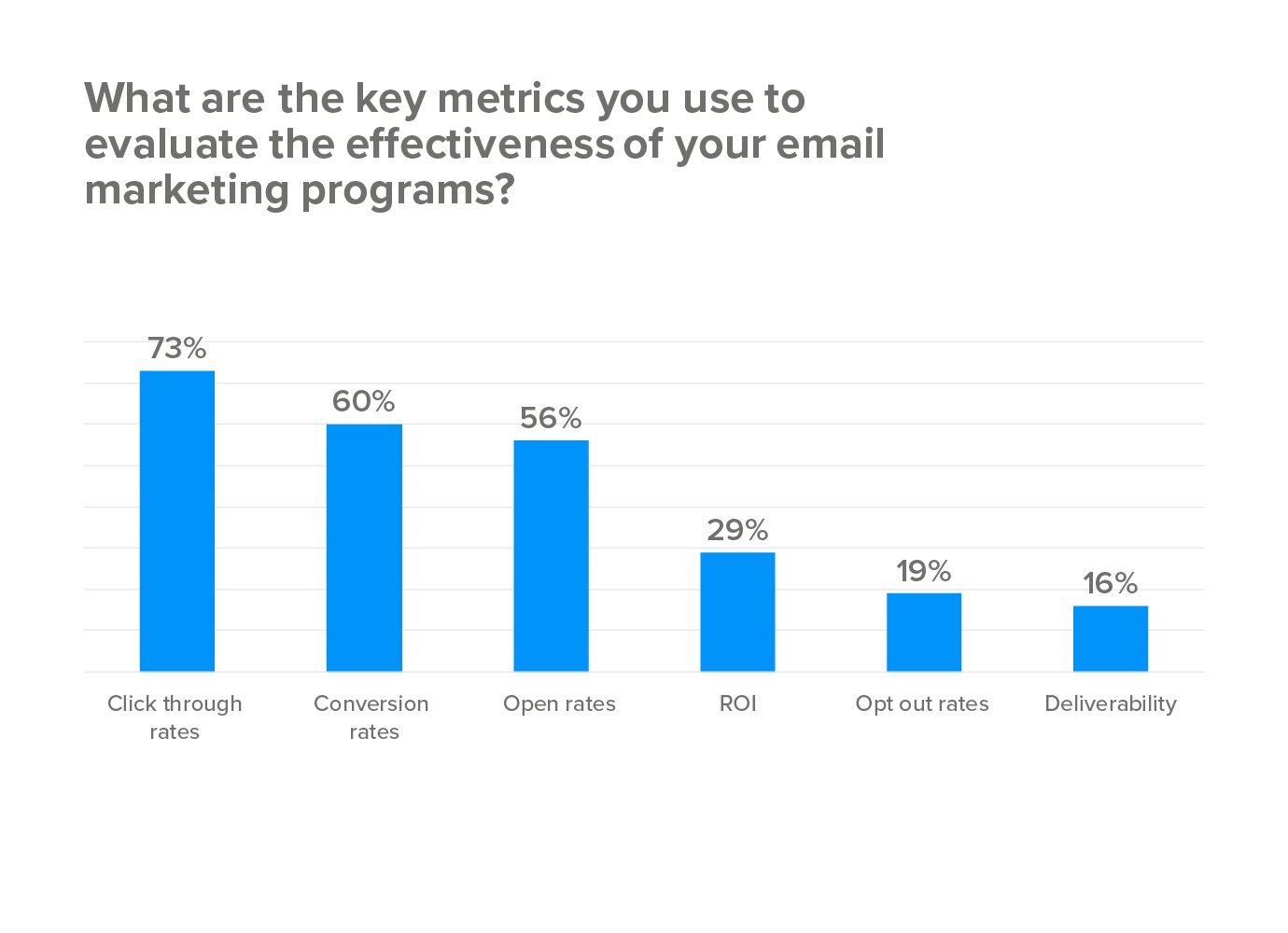
A high click-through rate is a good sign that your email campaign is relevant and that readers' are taking action. A low click-through rate means there's room to improve. But, what is a healthy email click through rate?
What is the average click through rate?
The best way to find out how you are doing is to compare your own data with the industry average.
On average, we receive 121 emails per day (that's up from 88 emails per day two years ago!). As the number of promotional emails we receive continues to grow, you would automatically think that the number of emails that people take action on has decreased.
But, it hasn’t decreased by as much as you would think.
In 2010, the average click-through rate was 3.56%.
Today, the average click through rate is a whopping 7% - making it a record year for average CTR!
So, if you’re getting email click through rates higher than 7%, well done you!
However, if your email click through rate is below 7%, then it might be time to find ways to increase engagement.
But, this data is universal.
And each country is different, right?
Well, not exactly.
The difference between the top performing countries and low performing countries isn’t that big.
For example, the difference between the UK top performers and the US top performer is 0.9 percent.
Based on the table below, it looks like international email marketing isn’t so different after all.
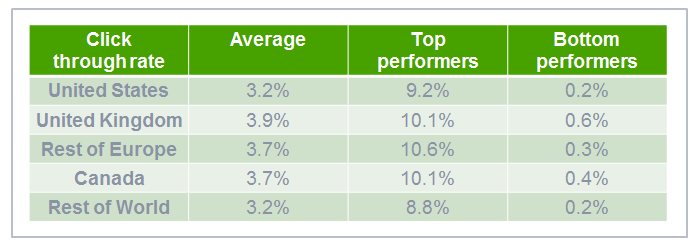
By now, you should have an understanding of how well you are performing in terms of the average CTR and within the country you market to. But, how important does the device an email is received on play when it comes to click through rates?
Let’s take a closer look.
How do click through rates compare by device?
The way people read your email campaigns plays an important role in how they respond to it.
Have you ever received an email on your phone that wasn’t optimized for mobile?
If so, then you will know how tiresome it can be to constantly pinch your fingers together in order to make the content more readable. But, that’s a lot of effort, which is why 70% of all readers delete an email that isn’t optimized for their device.
You can’t increase the email click through rate if your reader deletes your email, can you?
So, what kind of impact does device have on email click through rates?
Put simply: it has a massive impact.
Readers’ that open your email on their desktop are 3 times more likely to click on your campaign, than compared to mobile.
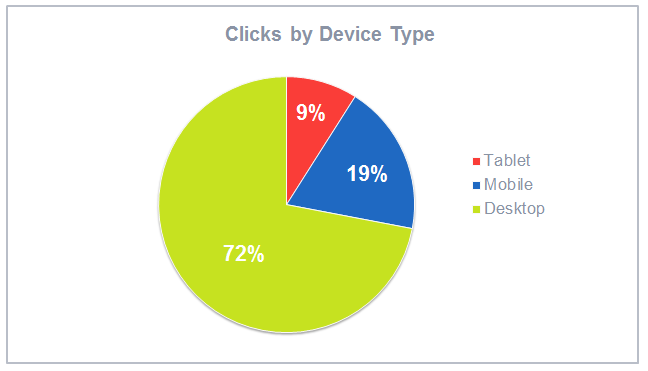
The challenge here is that more than 60% of emails are opened on a mobile device.
However, if your email campaign is optimized for mobile, then you will see an increase engagement, which is why 80% of brands always send optimized emails. In fact, emails that are optimized for mobile generate 15% higher click through rates (compared to emails that are not optimized for mobile)!
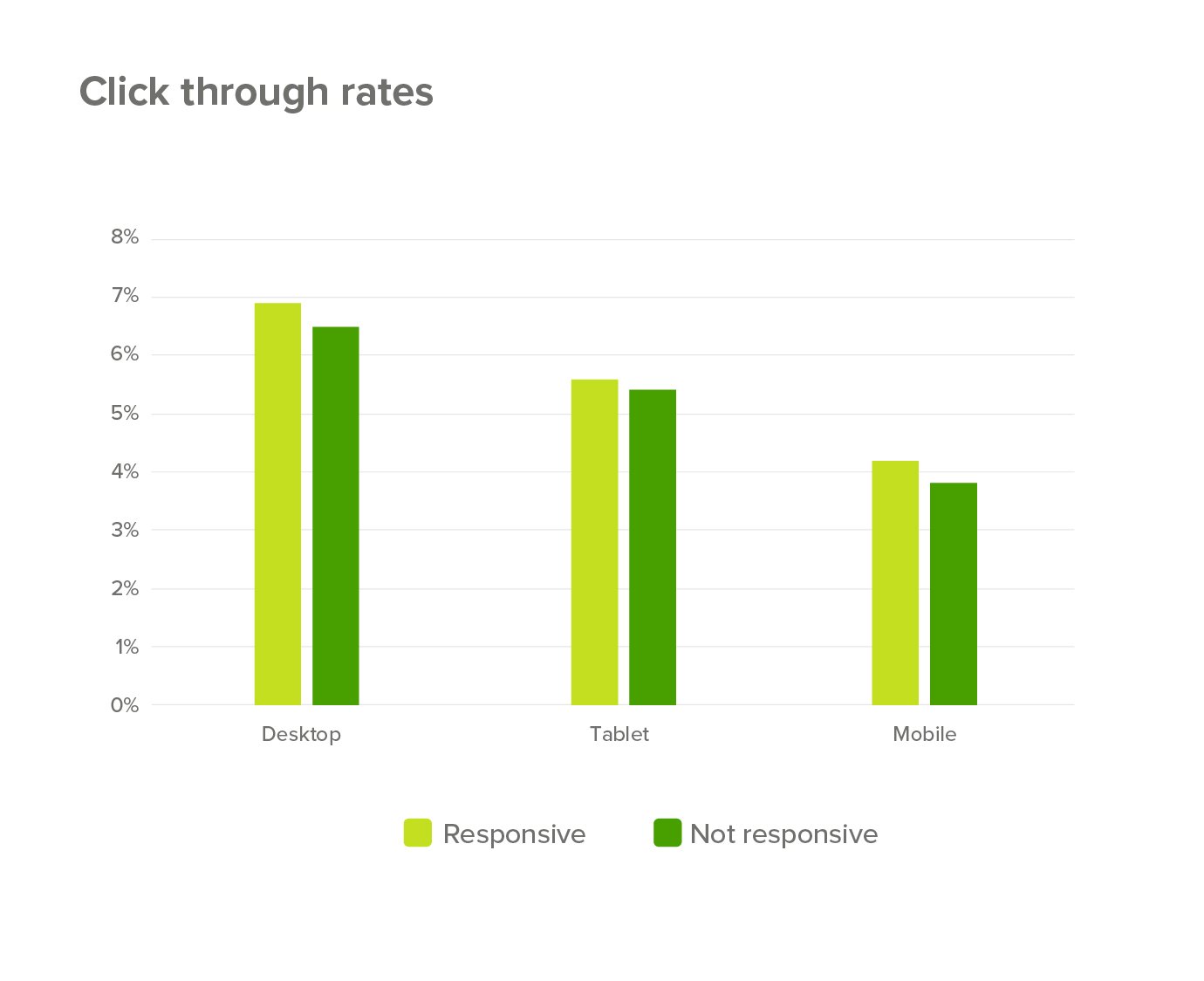
This trend will continue and so it goes without saying:
You need to optimize your emails for all devices.
What day should I send my email campaign?
When you send an email campaign can be the difference between a mediocre campaign and a successful campaign.
If that sounds extreme, then consider the fact that you can increase click through rates by 15% just by sending the email on a different day. It sounds easy enough, right?
Research by Get Response found that the best day to send an email to get the highest click through rate is on Monday and Tuesday (the worst day to send an email being Saturday).
The difference in click-through rate per day of the week is only marginal these days. So, if you’re used to sending emails on a Monday or Tuesday, it won’t hurt to try sending your next campaign out on a different day of the week to see how that performs instead.
If you’re like me, then your next question will be “what time should I send it?”
No one wants to see all of their hard work to waste by sending the email at the wrong time of day.
Fortunately, there’s a lot of data available on the best time of day to send your email campaign.
The same study by Get Response shows us that email click through rates are highest at 6am and 6pm - with a peak click through rate range between 11am and 2pm.
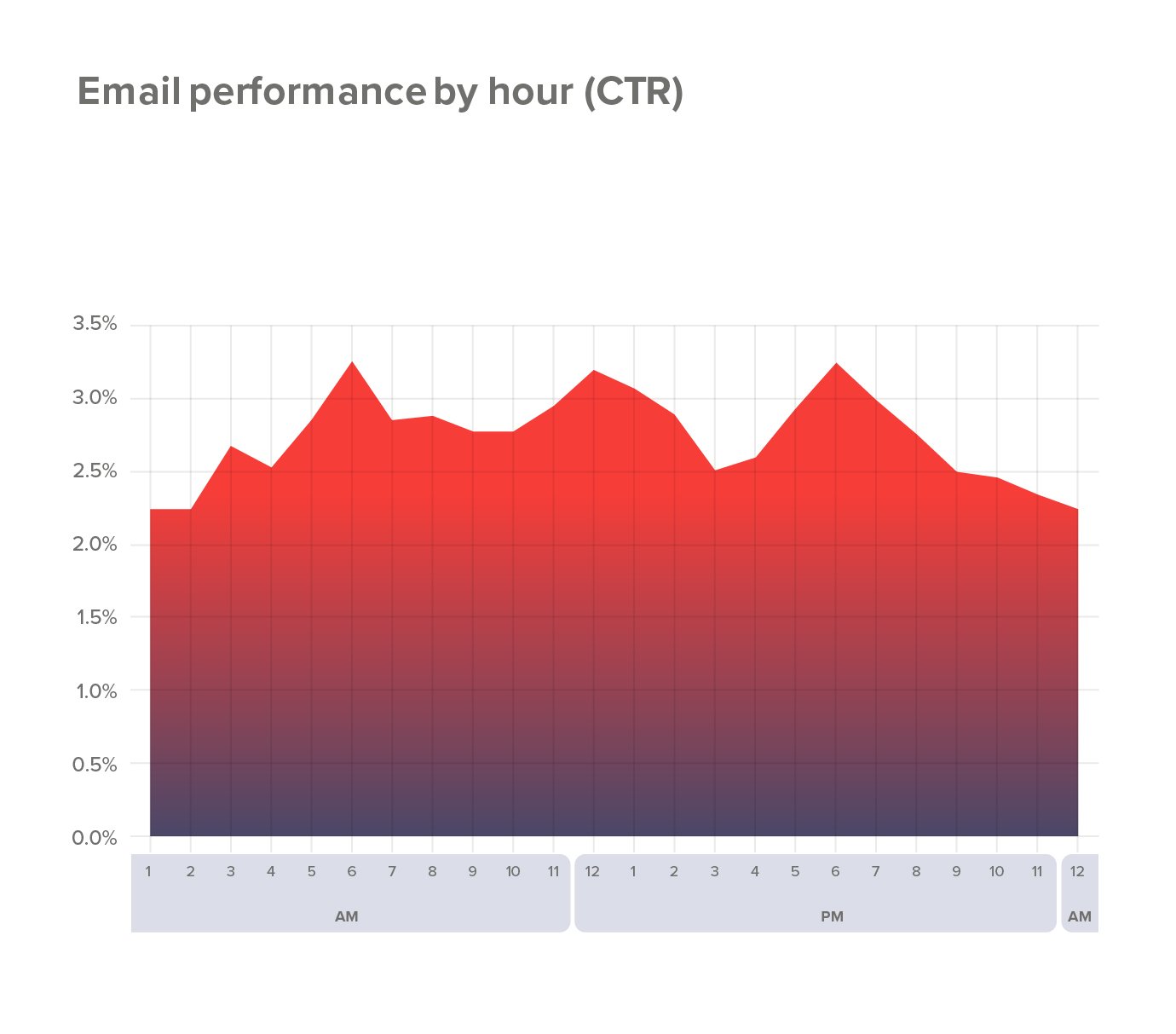
So, you should send your emails in the early afternoon, if you want to increase click through rate, right?
Well, not quite.
The real opportunity here lies in finding the time when people not only open an email, but read it and take action on it too. This is known as click to open rate (CTO). What you’re really looking for is to find the time when click-through rates are higher than email open rates.
Therefore, the best time to send an email to maximize open rates and click through rates is before and after daytime working hours.
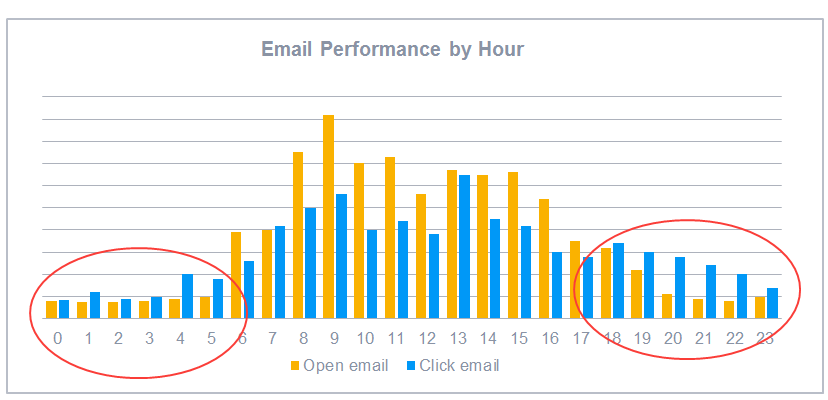
The reason why this is the ideal time is because the person you’re emailing isn’t busy working.
Instead, they are more relaxed and have time to read and engage with email campaigns. Rather than disrupting their workday and getting your campaign moved to the trash bin, your email campaign is being read and acted upon - and that’s how you earn higher click through rates.
How do I increase email click through rates?
The number one factor to why anyone clicks on a link in your email campaign is content.
Or, specifically:
Relevant content.
Relevant content in an email campaign will generate higher clicks.
Consider the two examples below:
- I’m an email marketer and I receive a promotional email on how to improve my email marketing campaigns. Inside the email includes 3 tips, and the call to action inside the email is “Click to see all 10 tips”.
- I’m an email marketer and I receive a promotional email that compares three types of accounting software. Inside the email includes a link to read a software comparison page.
Which email do you think I am more likely to click on?
Exactly. It’s the first one.
And it’s because the content is relevant to me.
Here's an example of the impact relevance in email marketing can have.
Recently, I sent out two email campaigns that had the same subject line and the same content inside the email.
The first email was sent to a segmented list (based on subscriber interests) and the second email was sent to the rest of the entire blog subscriber database.
Here's what happened next...
The second email, that was not segmented, earned a healthy 3.45% click through rate. Normally I'd be happy with that.
But the first email, the one that was segmented, earned a mind blowing 38.8% click through rate.
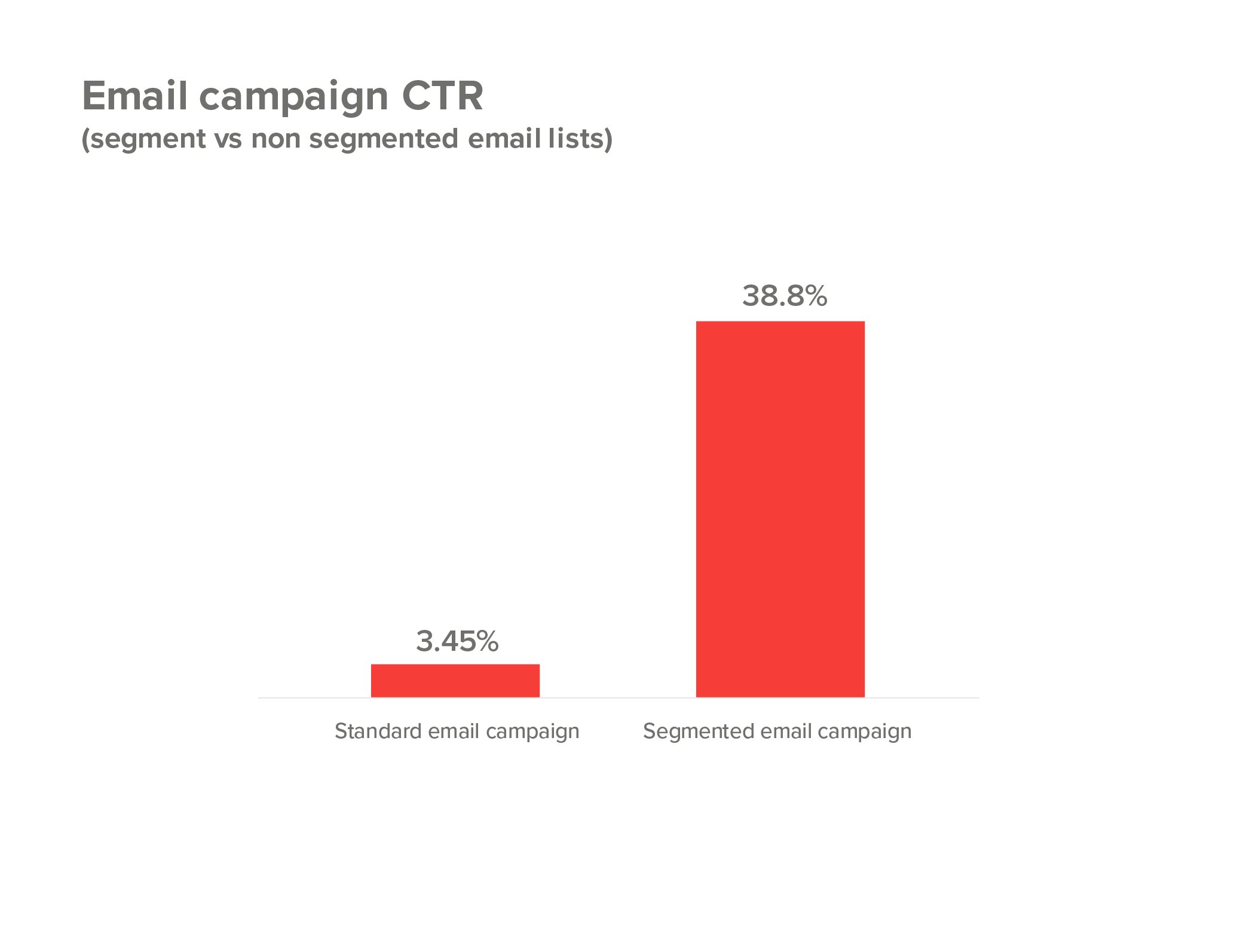
That's a 1,000% increase in CTR!
That's how powerful relevant content can be.
The good news is that isn't a one-time deal. Exactly one month later, I sent out a new email campaign to the segmented list and the email CTR was again 39%. That's one click from every 2.5 people who subscribe to my list!
If you haven't started to segment your email list, now might be a good time to start.
Especially with the new EU privacy General Data Protection Regulation (GDPR) that came into effect in May 2018. GDPR has had an impact on marketing and has changed the way marketing teams communicate with prospects and customers.
Another way to make email campaigns more relevant by personalizing them.
Studies show that marketers who use personalization to make their emails more relevant increase click through rates by as much as 139%!
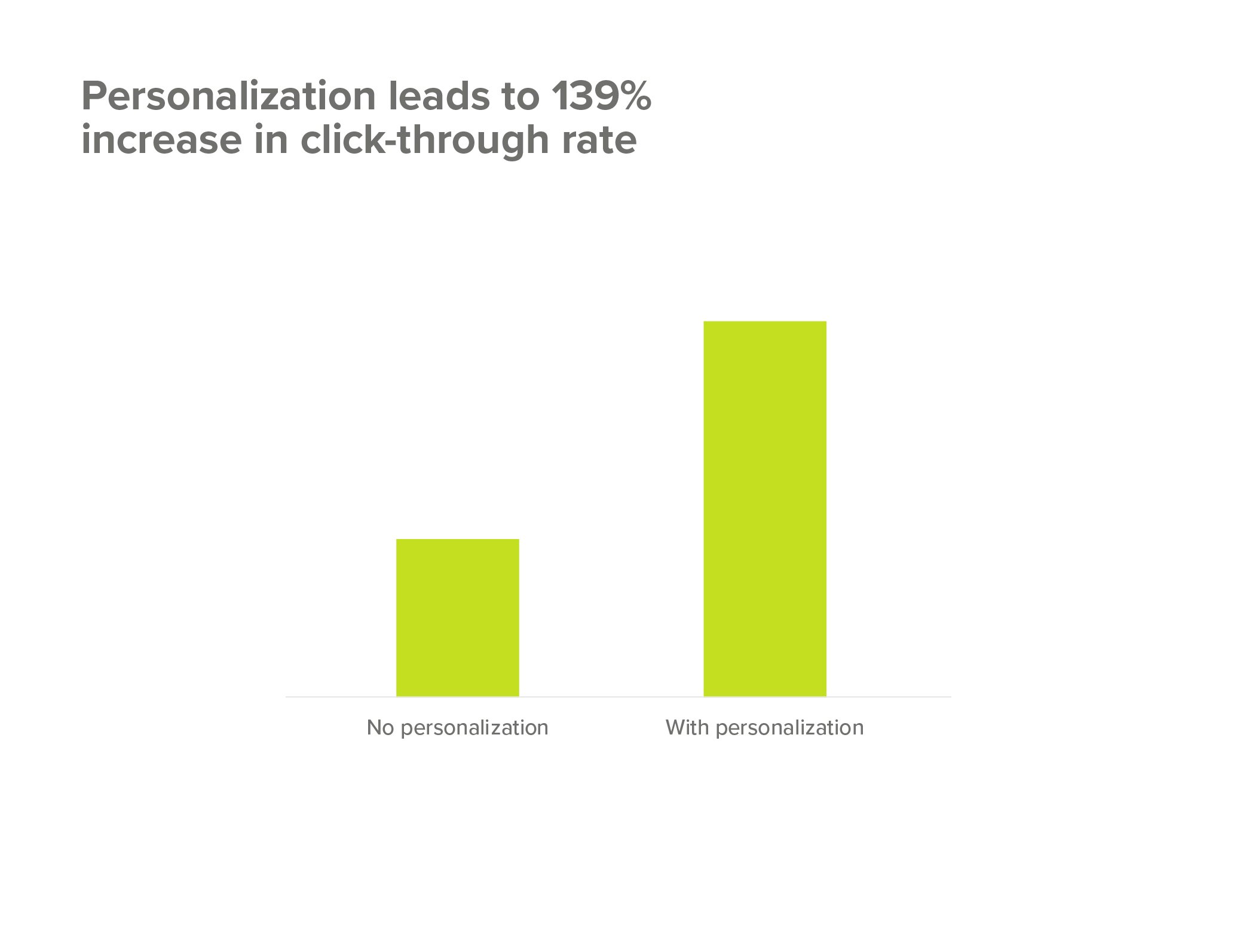
So, how can you include personalization into your campaigns?
One way to do this is to add the recipient’s name in the subject line of your email.
By adding the subscribers’ name in the subject line, it looks tailored to their needs and makes the content within the email feel personal (and relevant). This approach helped one B2B marketing team achieve a 17.3% increase in email click through rate.
You can also increase click through rates by sending fewer emails.
Research shows that marketers who send out one campaign per week get the highest average open and click-through rate. They see that 49% of all their customers use this approach.
If you send only one or two emails per month, now’s the time to look at ways to increase email frequency. You could be earning higher through rates.
Here's another idea you can use:
Can your readers share email content through social media?
My guess? Probably not.
Only 29% of email campaigns include social sharing icons.
Research from Get Response found that emails that include social sharing buttons have higher click through rates than emails that do not. The average click through rate for emails without social sharing icons was 2.4%, whereas the average click through rate for emails that did include social sharing icons was 6.2%.
That’s a 158% increase in click through rate!
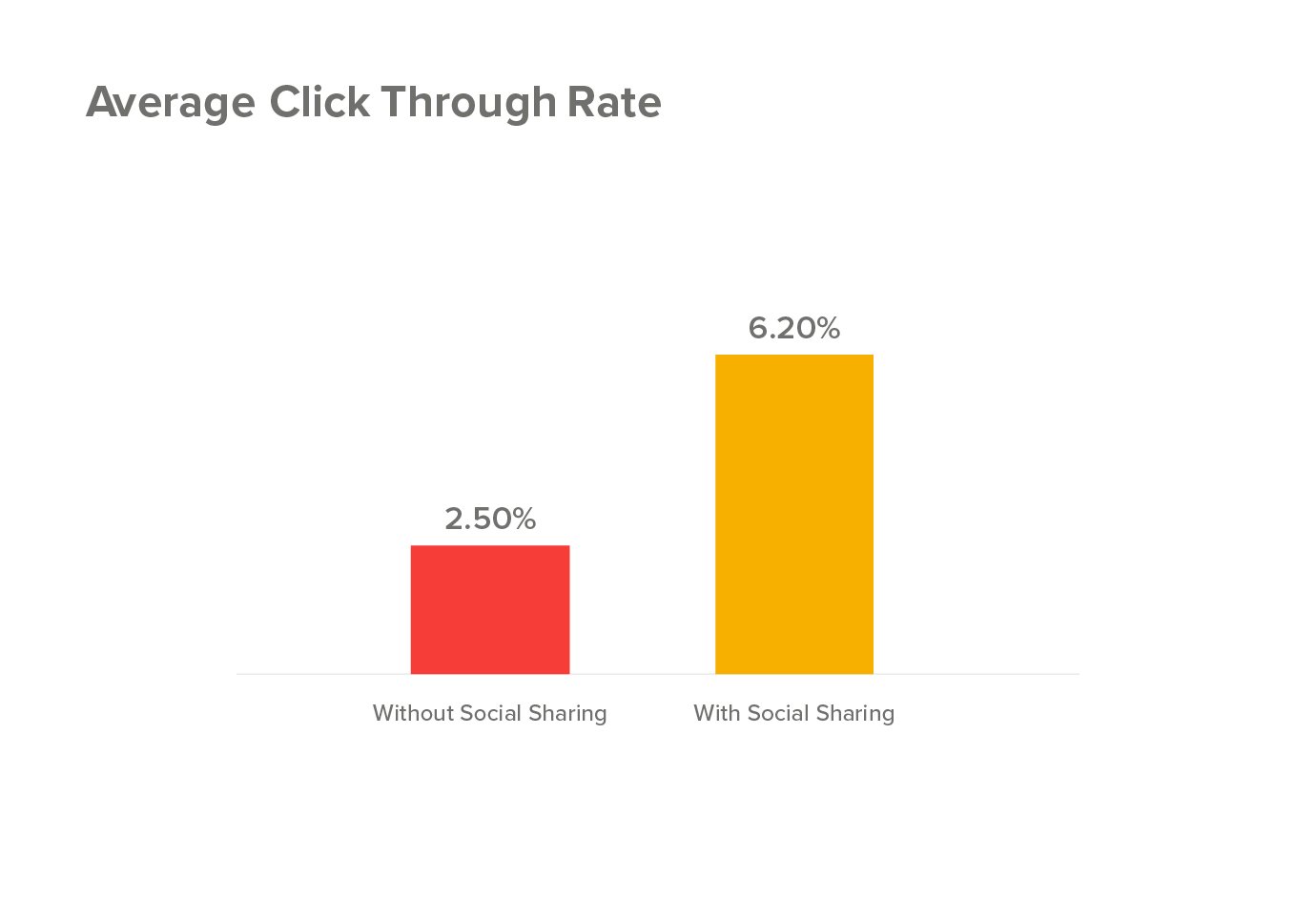
Of the social sharing icons included, LinkedIn receives the highest click through rates (7.9%), followed by Facebook (6.2%) and Twitter (6.2%).
So, the take away here is simple:
Add your social sharing icons to your email template. Easy enough, right?
How many CTA’s should I include in my email campaign?
A CTA, or call to action, is usually a button or text link that points to a landing page.
The average B2B newsletter contains 3 CTA's.
But, how many CTA's should you include in your campaigns?
The simple answer here is the fewer the better.
The example below shows two campaign emails sent out by Whirlpool.
The example on the left includes four CTA’s whereas their test email (on the right) includes only one.
Can you guess which email campaign performed better?
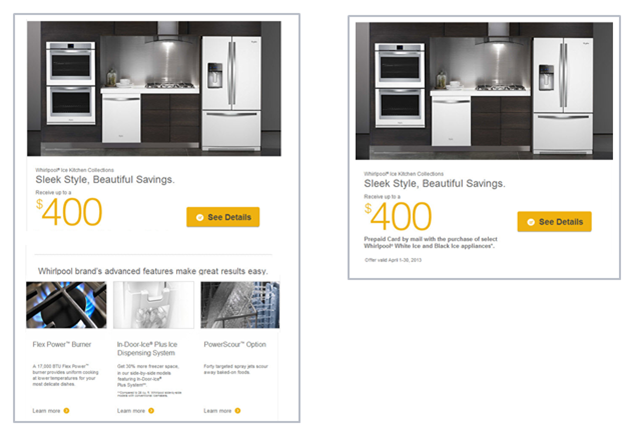
If you guessed the email with only one CTA, then you guessed right.
In this test, the email campaign that included only one CTA increased click through rate by 42%!
The reason for this huge jump in click through rate can be explained by paradox of choice where too many options leads us to do nothing.
A well cited example here comes from Sheena Iyengar, a professor and psychological researcher at the Columbia Business School, and her famous “Jam experience”.
In the "Jam experience" study, Sheena compared customer interaction and actual purchases between two different types of Jam displays. The first display featured 24 different flavors of jam, while the second display featured far fewer flavors and included only 6.
Here’s what happened:
While the display that featured 24 flavors of jam had a much higher engagement rate (more customers trying out the different flavors), only 3% of customers actually went on a purchase a jar of jam.
As for the display with only 6 flavors of jam, more than 30% people went on to purchase a jar!
The lesson here: Less is more.
How important is the CTA placement?
While the number of CTA’s plays a significant role in click through rates, another important factor is where the CTA is placed. So, where should you add your CTA?
Let’s let science decide.
In 2016, assistant professor Ashish Kumar from Aalto University and marketing professor Jari Salo from Oulu Business School published their study in the Journal of Marketing Communications on the "Effects of link placements in email newsletters on their click-through rate".
What they found was that "CTA's placed in the left region of an email have a larger impact on click through rate than CTA's placed in the right side with top-left".
Furthermore, the study found that "unlike the well-established Z-pattern of reading and web design, we find that when it comes to email engagement, it is more like a U-pattern, i.e. as users traverse the CTA's placed on a U-path, their responsiveness decreases gradually".
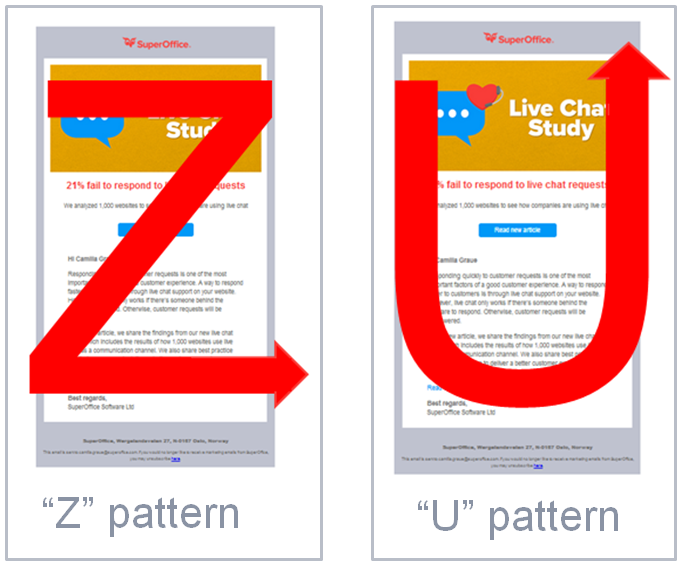
If most of your CTA's are found on the right hand side of your email marketing template, now might be the time to test a new email design and add your CTA on the left hand side.
Text vs buttons – which CTA should I choose?
In the early days of email marketing, a CTA meant a big orange/ green/ blue button. But, then email clients began to block images, which meant that buttons were no longer visible. And if your readers cannot see it, they can’t click on it!
To overcome this challenge, marketers started to use text links in their campaigns.
And then came along bulletproof buttons, buttons that will always be displayed, regardless of images being turned off or not. So, now marketers have a choice again. But, which CTA earns higher click through rates?
Campaign Monitor conducted a test to find out what CTA performs best and found that a call-to-action button helped them increase click-through rate by 28%!
Most people scan emails instead of reading them word for word. Using a button as a CTA will draw more attention to your offer and therefore, it's more likely to stand out to people who skim the copy. Whereas, a text link is easier to overlook.
While that is a significant improvement, at this stage I think it’s important that you test to see what works better for your audience. The point here is that if you use buttons today and your click through rate is low, try using text links instead in your next campaign.
Do images help (or hurt) click through rates?
Vero analyzed over 5,000 email campaigns and found that campaigns with images had a 42% higher CTR than campaigns without images. This data is backed up by MailChimp in a study of 5 billion (yes, billion) emails.
So yes, images do have a positive impact on click-through rates.
However, it comes down to the number of images.
The MailChimp study found that text-only (no images) campaigns do better than campaigns that include between 1-10 images. However, if your email includes more than 10 images (!), then click through rates skyrocket and outperform text-only campaigns!
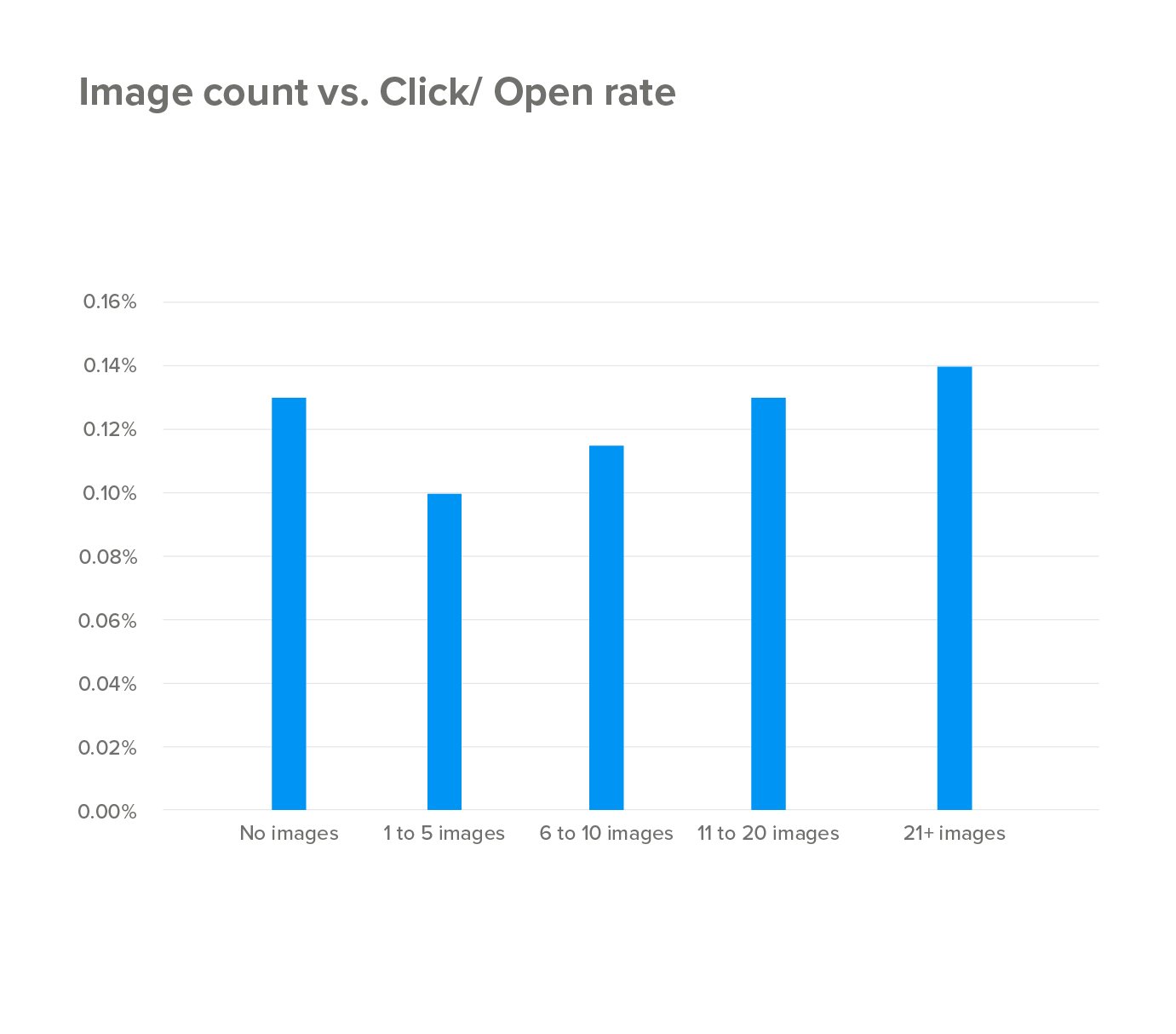
Here, you can take one of two paths:
You can either choose the less is more approach (with no images), or you can go all-in and add more than 11 images in your email campaign. Either way, you could try testing both and then compare click through rates for each campaign.
Email click through rate case study
We’re not perfect by any means, but we are open to testing new email marketing strategies.
So, putting some of the key findings above to use, we tested two types of email campaigns.
The first B2B email marketing example had no images, was optimized for mobile, included a single text link and was sent to our readers in the early hours of the morning (on the left). The second email we sent included one image, was less optimized for mobile, included a bright call to action button and was sent just before noon.
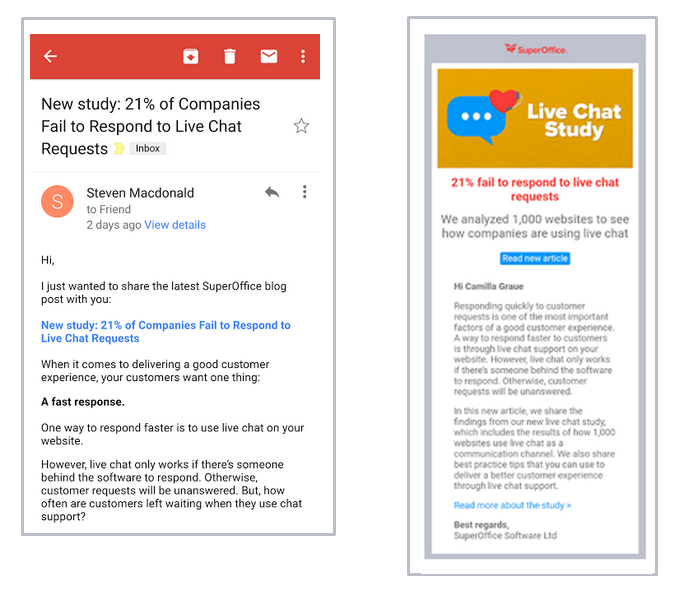
So, what happened?
Did the tips in this article increase click through rates?
Let's find out:
By following the science and data shared in this article, these small changes that were implemented in the first campaign earned an impressive 53% higher click through rate!
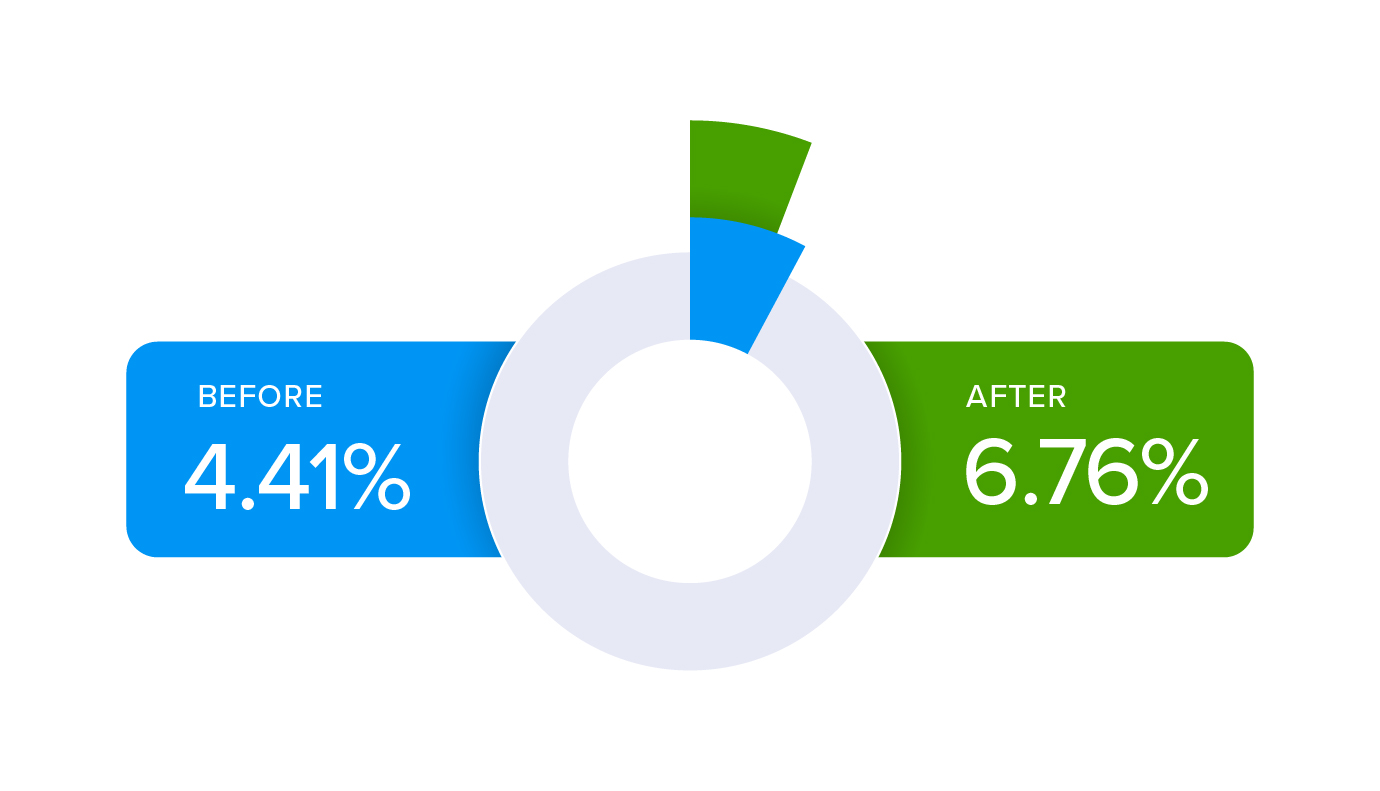
Conclusion
That was a lot of science and data on email click though rates!
But, this is data based on tens of billions of email campaigns that have been clicked. And we can use this science to increase our own click through rates.
Therefore, here are the key points for you to take away and use for the next time you send an email campaign to increase click through rates:
- Add social sharing icons to your email template
- Personalize subject lines with subscribers names
- Make sure your emails are optimized for all devices
- Include fewer CTA's and include try using text links
- Make your emails visual and include several images
- Try sending your email campaigns out on the weekend
- Test sending your emails in early morning or late evening
- Keep your CTA's to the top and to the left of your template
Of course, each campaign is different and so too will be your email marketing goals. But, the next time you send out an email campaign, try to include one or two of the above and compare it with previous send outs. If you find that your performance improves, then don’t stop there.
Add more of the tips in this post and you will soon see even higher click through rates!
Want to know more about SuperOffice for marketing? Book a demo today.
